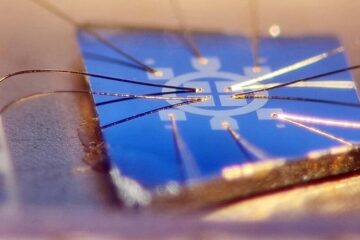Newly discovered breast milk antibodies help neutralize HIV

HIV-1 can be transmitted from mother to child via breastfeeding, posing a challenge for safe infant feeding practices in areas of high HIV-1 prevalence. But only one in 10 HIV-infected nursing mothers is known to pass the virus to their infants.
“That is remarkable, because nursing children are exposed multiple times each day during their first year of life,” said senior author Sallie Permar, M.D., Ph.D., an assistant professor of pediatrics and infectious diseases at Duke. “We are asking if there is an immune response that protects 90 percent of infants, and could we harness that response to develop immune system prophylaxis (protection) during breastfeeding for mothers infected with HIV-1.
“Our work helped establish that these B cells in breast milk can produce HIV-neutralizing antibodies, so enhancing the response or getting more mucosal B-cells to produce those helpful antibodies would be useful, and this is a possible route to explore for HIV-1 vaccine development,” Permar said.
The study was published on May 18 in PLoS One, an open-access journal published by the Public Library of Science.
“This is important work that seeks to understand what a vaccine must do to protect babies from mucosal transmission during breastfeeding,” said Barton Haynes, M.D., co-author and a national leader in AIDS/HIV research, director of the Center for HIV/AIDS Vaccine Immunology (CHAVI), as well as director of the Duke Human Vaccine Institute (DHVI). “The antibodies isolated are the first HIV antibodies isolated from breast milk that react with the HIV-1 envelope, and it important to understand how they work to attack HIV-1.”
The findings of two different antibodies with HIV-neutralizing properties isolated from breast milk also may help researchers with new investigations into adult-to-adult transmission, in addition to mother-to-child transmission.
Permar said that most HIV-1 transmission occurs at a mucosal site in the body – surfaces lined with epithelial cells, such as the gastrointestinal tract or vaginal tissue. The mucosal compartments all have their own immune system cells.
“We're excited about this finding because the immune cells in mucosal compartments can cross-talk and traffic between compartments,” Permar said. “So the antibodies we found in breast milk indicate that these same antibodies are able to be elicited in other tissues.”
Interestingly, the Centers for Disease Control in the U.S. recommend against breastfeeding if a mother has HIV-1, because baby formula is a safe alternative for U.S.-born infants. The World Health Organization, however, encourages HIV-infected nursing mothers in resource-poor regions to breastfeed while the mother and/or infant take antiretroviral drugs to prevent the infection in the infant, because without the nutrients and immune factors in mothers' milk, many more infants would die from severe diarrhea and respiratory and other diseases.
At the DHVI and CHAVI, there are many projects aimed at designing neutralizing responses in vaccinated individuals, and for improved vaccines that display specific targets to the immune system before it gets infected, with the idea of eliciting protective responses that fight against HIV transmission. “Our work will be important in eliminating mother-to-child transmission and getting the types of responses needed for protecting all infants,” Permar said.
The study itself wasn't easy to perform, she noted. The samples came from a group of women in Malawi who were recruited by CHAVI for this study.
“Successfully characterizing antibodies from such a fragile medium required global coordination and expertise across multiple fields and is a hopeful testament to the incredible amounts of work and leadership currently under way to fight this devastating disease,” said first author James Friedman, a third-year medical student at Duke University School of Medicine. “To be a part of, and to contribute to such a large-scale and important effort is incredibly exciting.”
Because of limited availability of the laboratory instrument needed to isolate single, viable immune cells in the region, the samples were not analyzed there. Instead, samples were frozen and transported for analysis. Keeping the breast milk under the right conditions for later thawing and testing of B cells and for isolating antibodies was a challenge, Permar said.
Other co-authors from the Duke Human Vaccine Institute were co-senior author Anthony Moody, S. Munir Alam, Xiaoying Shen, Shi-Mao Xia, Shelley Stewart, Kara Anasti, Justin Pollara, Genevieve G. Fouda, Guang Yang, Garnett Kelsoe, Guido Ferrari, Georgia D. Tomaras, and Hua-Xin Liao.
The study was funded by the National Institutes of Health (NIH/NIAID/DAIDS) grants: the Center for HIV/AIDS Vaccine Immunology (CHAVI) AI067854, AI07392, and AI087992; and the Doris Duke Foundation Clinical Scientist Development Award. The Bill and Melinda Gates Foundation Collaboration for AIDS Vaccine Discovery (CAVDVIMC grant 38619) provided additional funding for this work.
Media Contact
More Information:
http://www.duke.eduAll latest news from the category: Life Sciences and Chemistry
Articles and reports from the Life Sciences and chemistry area deal with applied and basic research into modern biology, chemistry and human medicine.
Valuable information can be found on a range of life sciences fields including bacteriology, biochemistry, bionics, bioinformatics, biophysics, biotechnology, genetics, geobotany, human biology, marine biology, microbiology, molecular biology, cellular biology, zoology, bioinorganic chemistry, microchemistry and environmental chemistry.
Newest articles

Boron deficiency: oilseed rape reacts as with infection and pest infestation
Genetic mechanisms uncovered… Boron deficiency has a devastating effect on oilseed rape and related plants. However, little is known about the underlying genetic mechanisms. A study shows that the response…

Quantum Precision: A New Kind of Resistor
Researchers at the University of Würzburg have developed a method that can improve the performance of quantum resistance standards. It´s based on a quantum phenomenon called Quantum Anomalous Hall effect….

Security vulnerability in browser interface
… allows computer access via graphics card. Researchers at Graz University of Technology were successful with three different side-channel attacks on graphics cards via the WebGPU browser interface. The attacks…





















